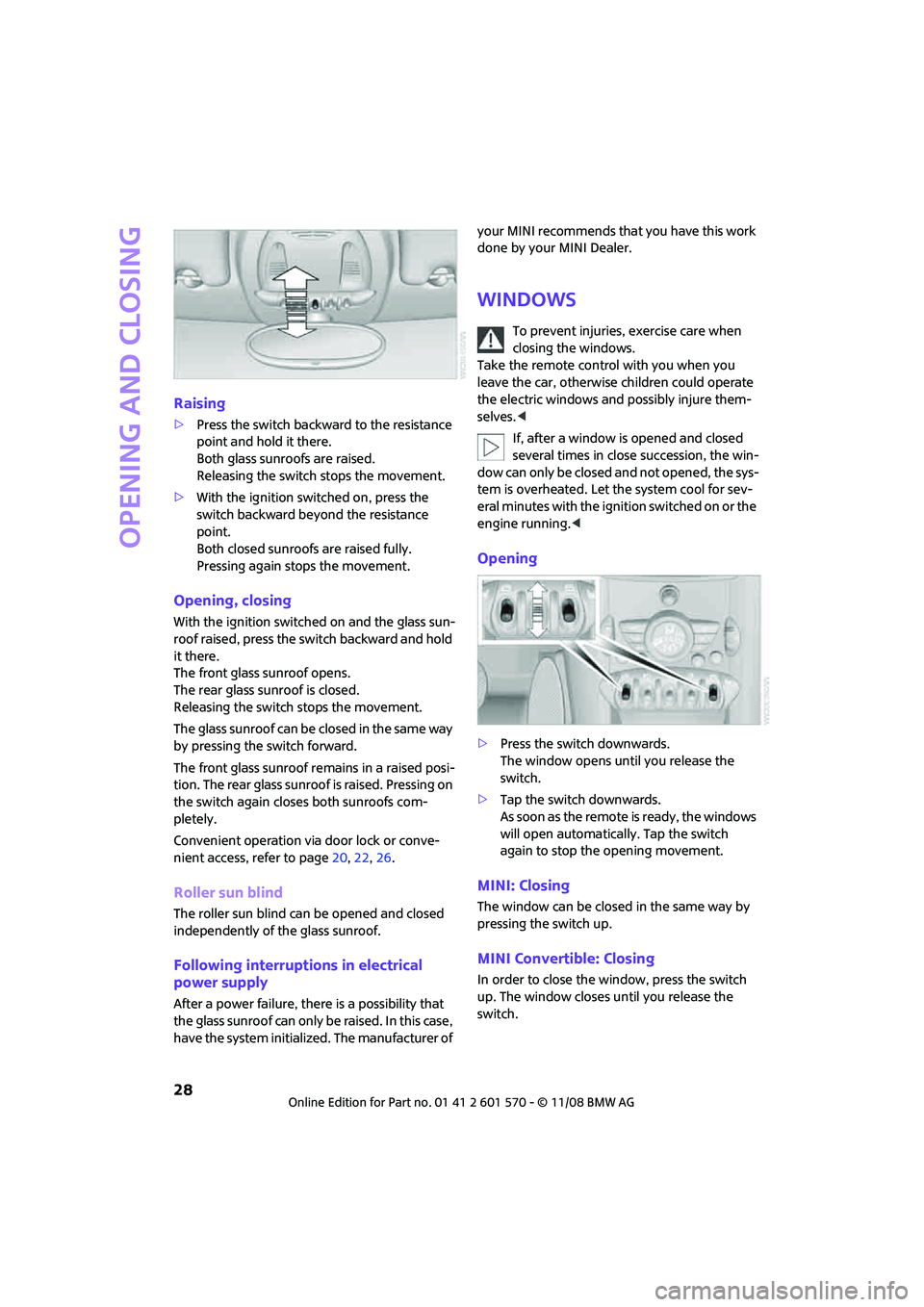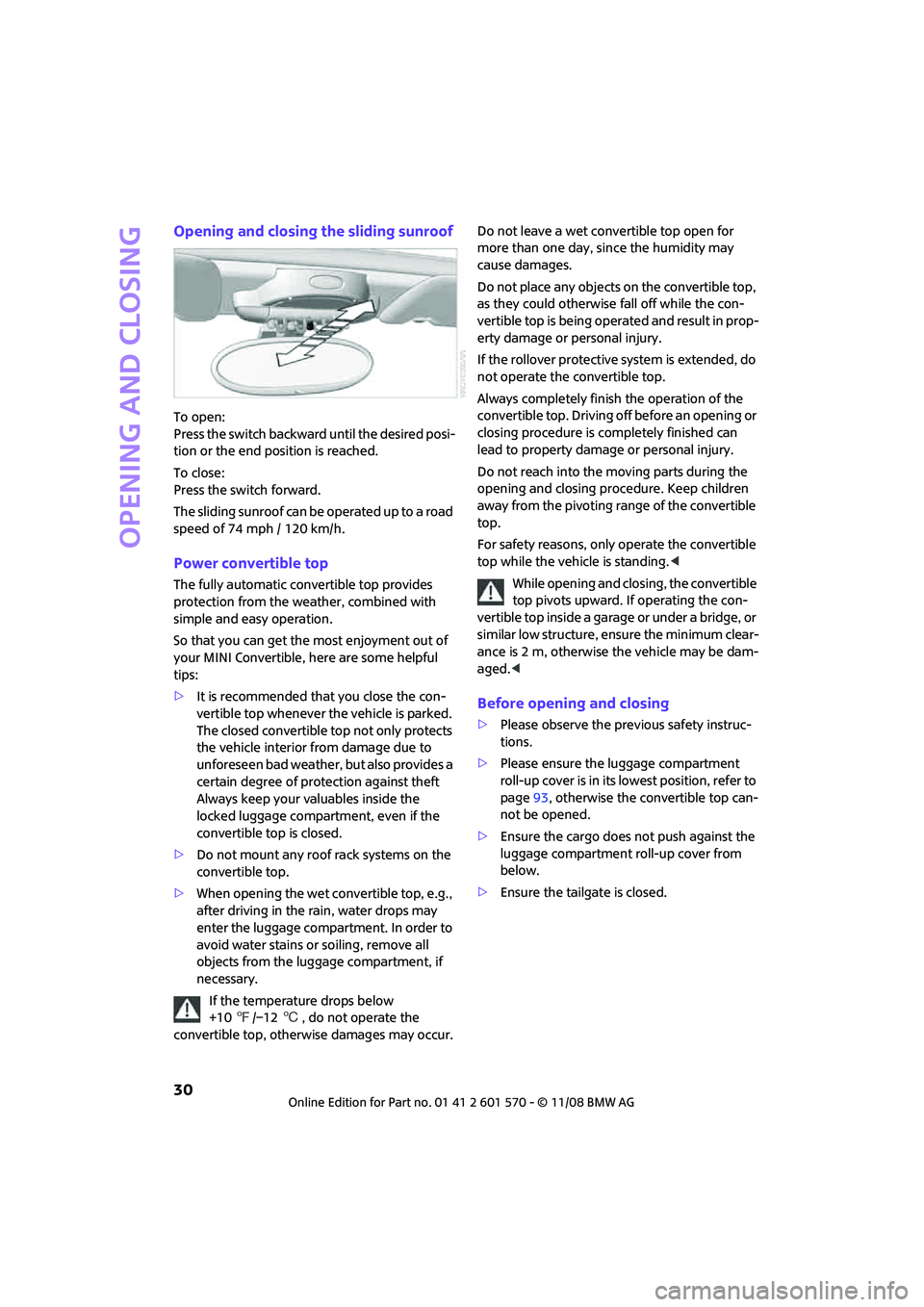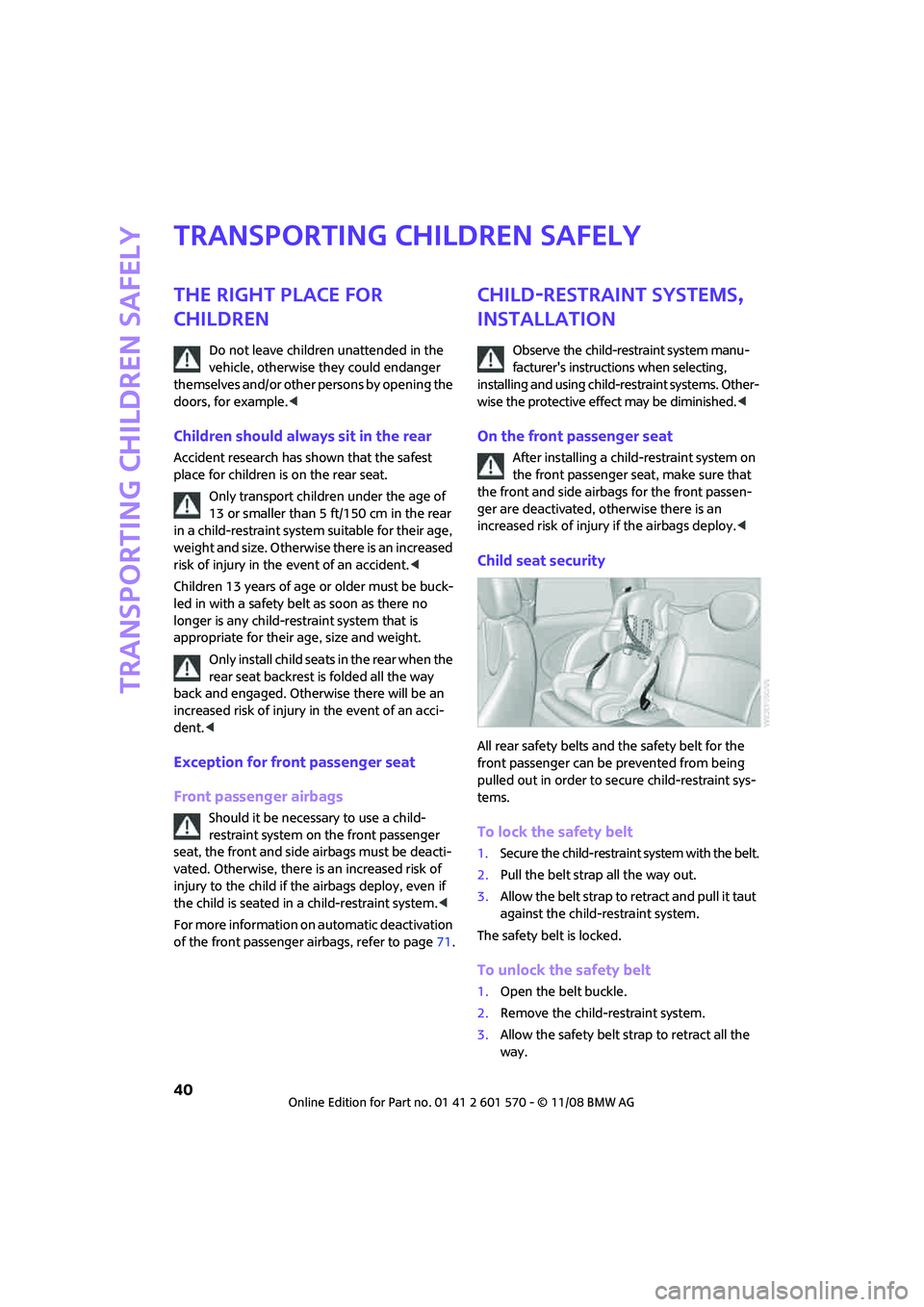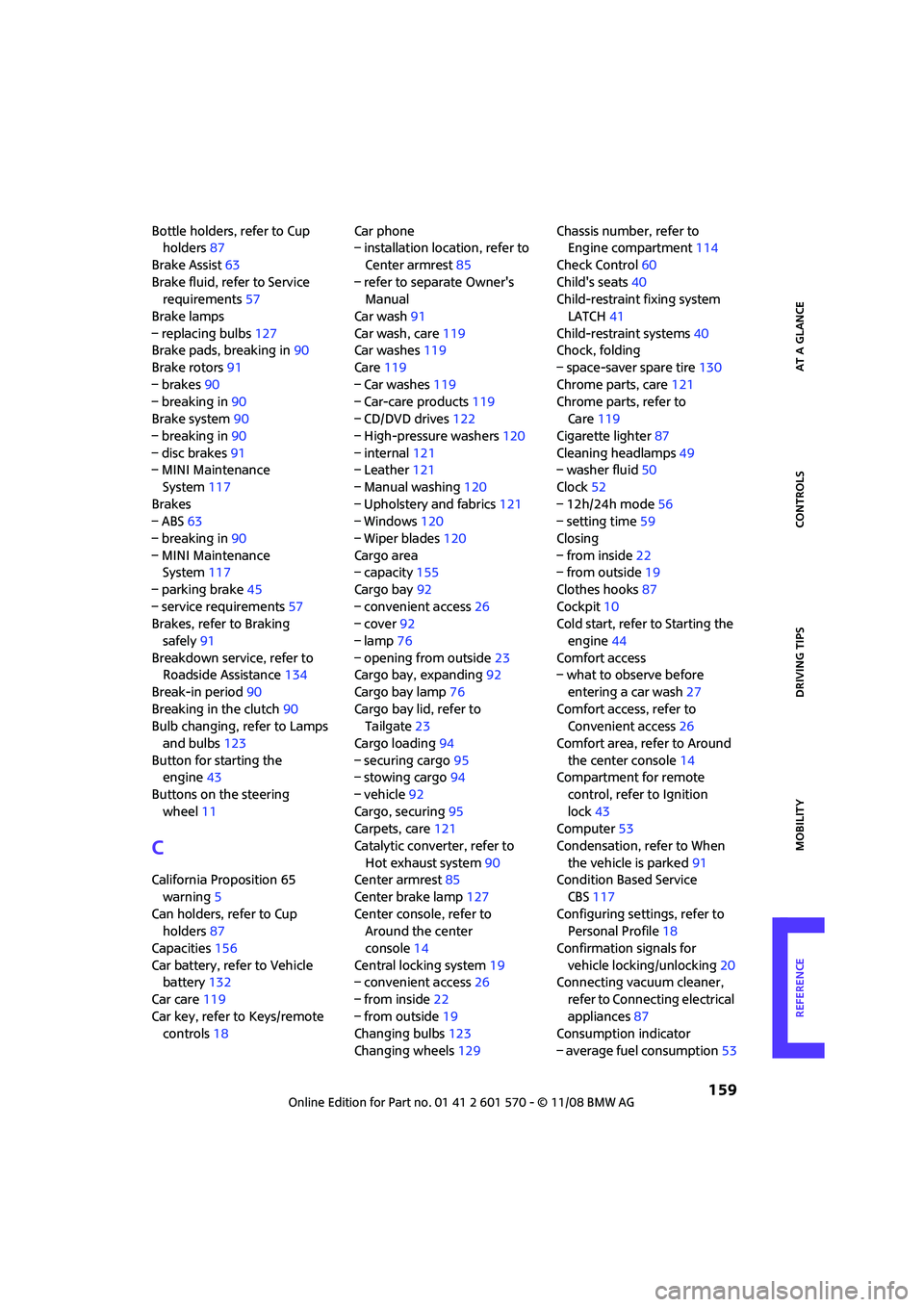child lock MINI COOPER CONVERTIBLE 2009 Owners Manual
[x] Cancel search | Manufacturer: MINI, Model Year: 2009, Model line: COOPER CONVERTIBLE, Model: MINI COOPER CONVERTIBLE 2009Pages: 172, PDF Size: 2.73 MB
Page 29 of 172

REFERENCEAT A GLANCE CONTROLS DRIVING TIPS MOBILITY
27
Switching on radio readiness
Switch on radio readiness by briefly pressing the
start/stop button, page43.
Do not depress the brake or the clutch,
otherwise the engine will start.<
Starting the engine
The engine can be started or the ignition can be
switched on when a remote control is inside the
vehicle. It is not necessary to insert a remote
control into the ignition lock, page43.
Switching off the engine in cars with
automatic transmission
The engine can only be switched off when the
selector lever is in position P, page44.
To switch the engine off when the selector lever
is in position N, the remote control must be in
the ignition lock.
Before driving a vehicle with automatic
transmission into a car wash
1.Insert remote control into ignition lock.
2.Depress the brake.
3.Move the selector lever to position N.
4.Switch off the engine.
The vehicle can roll.
Malfunction
Convenient access may malfunction due to local
radio waves.
If this happens, open or close the vehicle via the
buttons on the remote control or using the inte-
grated key.
Insert the remote control into the ignition lock
and start the engine.
Warning lamps
The warning lamp comes on when an
attempt is made to start the engine: the
engine cannot be started. The remote
control is not inside the vehicle or is malfunction-
ing. Take the remote control with you inside the
vehicle or have it checked. If necessary, insert
another remote control into the ignition lock.The warning lamp comes on when the
engine is running: the remote control is
no longer inside the vehicle. After the
engine is switched off, the engine can only be
restarted within approx. 10 seconds.
The indicator lamp comes on: replace
the battery in the remote control.
Replacing the battery
The remote control for convenient access con-
tains a battery that will need to be replaced from
time to time.
1.Remove the cover.
2.Insert the new battery with the plus side fac-
ing up.
3.Press the cover on to close.
Take the old battery to a battery collection
point or to your MINI Dealer.<
Glass sunroof, electric*
To prevent injuries, exercise care when
closing the glass sunroof and keep it in
your field of vision until it is shut.
Take the key with you when you leave the car,
otherwise children could operate the sunroof
and possibly injure themselves.<
Page 30 of 172

Opening and closing
28
Raising
>Press the switch backward to the resistance
point and hold it there.
Both glass sunroofs are raised.
Releasing the switch stops the movement.
>With the ignition switched on, press the
switch backward beyond the resistance
point.
Both closed sunroofs are raised fully.
Pressing again stops the movement.
Opening, closing
With the ignition switched on and the glass sun-
roof raised, press the switch backward and hold
it there.
The front glass sunroof opens.
The rear glass sunroof is closed.
Releasing the switch stops the movement.
The glass sunroof can be closed in the same way
by pressing the switch forward.
The front glass sunroof remains in a raised posi-
tion. The rear glass sunroof is raised. Pressing on
the switch again closes both sunroofs com-
pletely.
Convenient operation via door lock or conve-
nient access, refer to page20,22,26.
Roller sun blind
The roller sun blind can be opened and closed
independently of the glass sunroof.
Following interruptions in electrical
power supply
After a power failure, there is a possibility that
the glass sunroof can only be raised. In this case,
have the system initialized. The manufacturer of your MINI recommends that you have this work
done by your MINI Dealer.
Windows
To prevent injuries, exercise care when
closing the windows.
Take the remote control with you when you
leave the car, otherwise children could operate
the electric windows and possibly injure them-
selves.<
If, after a window is opened and closed
several times in close succession, the win-
dow can only be closed and not opened, the sys-
tem is overheated. Let the system cool for sev-
eral minutes with the ignition switched on or the
engine running.<
Opening
>Press the switch downwards.
The window opens until you release the
switch.
>Tap the switch downwards.
A s s o o n a s t h e r e m o t e is r e a d y , t h e w i n d o w s
will open automatically. Tap the switch
again to stop the opening movement.
MINI: Closing
The window can be closed in the same way by
pressing the switch up.
MINI Convertible: Closing
In order to close the window, press the switch
up. The window closes until you release the
switch.
Page 32 of 172

Opening and closing
30
Opening and closing the sliding sunroof
To open:
Press the switch backward until the desired posi-
tion or the end position is reached.
To close:
Press the switch forward.
The sliding sunroof can be operated up to a road
speed of 74 mph / 120 km/h.
Power convertible top
The fully automatic convertible top provides
protection from the weather, combined with
simple and easy operation.
So that you can get the most enjoyment out of
your MINI Convertible, here are some helpful
tips:
>It is recommended that you close the con-
vertible top whenever the vehicle is parked.
The closed convertible top not only protects
the vehicle interior from damage due to
unforeseen bad weather, but also provides a
certain degree of protection against theft
Always keep your valuables inside the
locked luggage compartment, even if the
convertible top is closed.
>Do not mount any roof rack systems on the
convertible top.
>When opening the wet convertible top, e.g.,
after driving in the rain, water drops may
enter the luggage compartment. In order to
avoid water stains or soiling, remove all
objects from the luggage compartment, if
necessary.
If the temperature drops below
+10 7/–12 6 , do not operate the
convertible top, otherwise damages may occur.Do not leave a wet convertible top open for
more than one day, since the humidity may
cause damages.
Do not place any objects on the convertible top,
as they could otherwise fall off while the con-
vertible top is being operated and result in prop-
erty damage or personal injury.
If the rollover protective system is extended, do
not operate the convertible top.
Always completely finish the operation of the
convertible top. Driving off before an opening or
closing procedure is completely finished can
lead to property damage or personal injury.
Do not reach into the moving parts during the
opening and closing procedure. Keep children
away from the pivoting range of the convertible
top.
For safety reasons, only operate the convertible
top while the vehicle is standing.<
While opening and closing, the convertible
top pivots upward. If operating the con-
vertible top inside a garage or under a bridge, or
similar low structure, ensure the minimum clear-
ance is 2 m, otherwise the vehicle may be dam-
aged.<
Before opening and closing
>Please observe the previous safety instruc-
tions.
>Please ensure the luggage compartment
roll-up cover is in its lowest position, refer to
page93, otherwise the convertible top can-
not be opened.
>Ensure the cargo does not push against the
luggage compartment roll-up cover from
below.
>Ensure the tailgate is closed.
Page 36 of 172

Adjustments
34
Adjustments
Sitting safely
The ideal sitting position can make a vital contri-
bution to relaxed, fatigue-free driving. In con-
junction with the safety belts, the head restraints
and the airbags, the seated position has a major
influence on your safety in the event of an acci-
dent. To ensure that the safety systems operate
with optimal efficiency, we strongly urge you to
observe the instructions contained in the follow-
ing section.
For additional information on transporting chil-
dren safely, refer to page40.
Airbags
Always maintain an adequate distance
between yourself and the airbags. Always
grip the steering wheel on the rim, with your
hands in the 3 o'clock and 9 o'clock positions, to
minimize the risk of injury to the hands or arms
in the event of the airbag being triggered off.
No one and nothing is to come between the air-
bags and the seat occupant.
Do not use the cover of the front airbag on the
front passenger side as a storage area. Ensure
that the front passenger is correctly seated, e.g.
that no feet or legs are propped against the
dashboard. Otherwise, leg injury could result if
the front airbag suddenly deployed.
Make sure that passengers do not lean their
heads against the side airbags, otherwise seri-
ous injuries could result if the airbags suddenly
deployed.<
Even if you follow all the instructions, injuries
resulting from contact with airbags cannot be
fully excluded, depending on the circumstances.
The ignition and inflation noise may provoke a
mild hearing loss in extremely sensitive individ-
uals. This effect is usually only temporary.
For airbag locations and additional information
on airbags, refer to page70.
Head restraint
A correctly adjusted head restraint reduces the
risk of neck injury in the event of an accident.
Adjust the head restraint in such a way
that its center is at approx. ear level. Oth-
erwise, there is an increased risk of injury in the
event of an accident.<
Head restraints, refer to page36.
Safety belt
Before every drive, make sure that all occupants
wear their safety belts. Airbags complement the
safety belt as an additional safety device, but
they do not represent a substitute.
Never allow more than one person to wear
a single safety belt. Never allow infants or
small children to ride in a passenger's lap.
Make sure that the belt in the lap area sits low
across the hips and does not press against the
abdomen. The safety belt must not rest against
the throat, run across sharp edges, pass over
hard or fragile objects or be pinched. Fasten the
safety belt so that it is pulled taut across the lap
and shoulder, fitting the body snugly without any
twists. Otherwise the belt could slide over the
hips in the event of a frontal collision and injure
the abdomen. Avoid wearing bulky clothing and
regularly pull the belt in the upper-body area
taut, otherwise its restraining effect could be
impaired.<
Safety belts, refer to page37.
Seats
Note before adjusting
Never attempt to adjust your seat while
the vehicle is moving. The seat could
respond with unexpected movement, and the
ensuing loss of vehicle control could lead to an
accident.
On the front passenger seat as well, do not
incline the backrest too far to the rear while the
Page 42 of 172

Transporting children safely
40
Transporting children safely
The right place for
children
Do not leave children unattended in the
vehicle, otherwise they could endanger
themselves and/or other persons by opening the
doors, for example.<
Children should always sit in the rear
Accident research has shown that the safest
place for children is on the rear seat.
Only transport children under the age of
13 or smaller than 5 ft/150 cm in the rear
in a child-restraint system suitable for their age,
weight and size. Otherwise there is an increased
risk of injury in the event of an accident.<
Children 13 years of age or older must be buck-
led in with a safety belt as soon as there no
longer is any child-restraint system that is
appropriate for their age, size and weight.
Only install child seats in the rear when the
rear seat backrest is folded all the way
back and engaged. Otherwise there will be an
increased risk of injury in the event of an acci-
dent.<
Exception for front passenger seat
Front passenger airbags
Should it be necessary to use a child-
restraint system on the front passenger
seat, the front and side airbags must be deacti-
vated. Otherwise, there is an increased risk of
injury to the child if the airbags deploy, even if
the child is seated in a child-restraint system.<
For more information on automatic deactivation
of the front passenger airbags, refer to page71.
Child-restraint systems,
installation
Observe the child-restraint system manu-
facturer's instructions when selecting,
installing and using child-restraint systems. Other-
wise the protective effect may be diminished.<
On the front passenger seat
After installing a child-restraint system on
the front passenger seat, make sure that
the front and side airbags for the front passen-
ger are deactivated, otherwise there is an
increased risk of injury if the airbags deploy.<
Child seat security
All rear safety belts and the safety belt for the
front passenger can be prevented from being
pulled out in order to secure child-restraint sys-
tems.
To lock the safety belt
1.Secure the child-restraint system with the belt.
2.Pull the belt strap all the way out.
3.Allow the belt strap to retract and pull it taut
against the child-restraint system.
The safety belt is locked.
To unlock the safety belt
1.Open the belt buckle.
2.Remove the child-restraint system.
3.Allow the safety belt strap to retract all the
way.
Page 44 of 172

Transporting children safely
42
MINI Convertible
1Direction of travel
2Head restraint
3Rollover protection system
4Tether strap hook
5Cargo bay floor
6Anchor
7Seat backrest
8Tether strap of the child-restraint system
1.Push the head restraint upward.
2.Unlock backrest and slightly fold forward,
see page93.
3.Guide the tether strap between the head
restraint holders.
4.Attach the tether strap to the anchor using
the hook.
5.Fold backrest back and lock in place. Push
headrest down as far as possible.
6.Pull the retaining strap tight.
Ensure to guide the upper retaining strap
between the backrest and rollover protec-
tion system, otherwise the belt will not secure
the child-restraining system in accordance with
the law.<
Page 94 of 172

Things to remember when driving
92
With convenient access and automatic
transmission
Insert the key into the ignition lock.
The engine can be switched off when the selec-
tor lever is in position N. Refer also to page27.
Cargo loading
To avoid loading the tires beyond their
approved carrying capacity, never over-
load the vehicle. Overloading can lead to over-
heating and increases the rate at which damage
develops inside the tires. The ultimate result can
assume the form of a sudden blow-out.<
Avoid fluid spills in the cargo bay as they
could damage the vehicle.<
MINI: Cargo bay
Cargo bay cover
Do not place any objects on the cover,
otherwise they could endanger the car's
occupants, e.g. in the case of braking or sudden
swerving, or they may damage the cover.<
When you open the tailgate, the cargo bay cover
is raised.
To load bulky luggage, the cover can be
removed.
1.Unhook the lift straps from the tailgate.
2.Pull the cover out of the holders toward the
rear.
Expanding the cargo bay
The rear set backrest is split. Both sides can be
folded separately to expand the cargo bay.
1.Pull the lever.
2.Fold rear seat backrests forward.
When folding the backrest back up, make
sure that the seat's locking mechanisms
engage properly. Otherwise, cargo could be
thrown around in the event of sharp braking or
swerving and endanger the occupants.<
Adjusting rear seat backrest*
Expand the cargo bay by raising the split rear
seat backrests to a steeper angle.
1.Pull the lever, arrow1, and fold the rear seat
backrest forward.
2.Fold up the lever of the backrest lock until it
audibly engages, arrow2.
3.Fold back the backrest until it engages.
If the rear seat backrests are positioned at
a steeper angle, do not install child-
restraint systems in the rear of the vehicle as
their protective features may be ineffective.<
Page 117 of 172

REFERENCEAT A GLANCE CONTROLS DRIVING TIPS MOBILITY
115
Adding engine oil
Do not add the maximum quantity of 1 US
quart/1 liter of engine oil until the oil level has
dropped to just above the lower mark on the
dipstick, page114.
Add oil within the next 30 miles/50 km,
otherwise the engine could be dam-
aged.<
Keep oils, greases, etc. out of the reach of
children and comply with the warnings on
the containers. Otherwise, health hazards may
result.<
Oil change
Have the oil changed only by a MINI Dealer or a
workshop that has specially trained personnel
working in accordance with the specifications of
the MINI manufacturer.
Approved engine oils
The quality of the engine oil selected has critical
significance for the operation and service life of
an engine. Based on extensive testing, the man-
ufacturer of your MINI approves only certain
grades of engine oil on a regular basis.
Only use High Performance Synthetic Oil
approved by the manufacturer of your MINI.
If MINI High Performance Synthetic Oil is not
available, you can add small quantities of
another synthetic oil in between oil changes.
Only use oils with the API SM specification or
higher.
If you have any further questions regard-
ing MINI High Performance Synthetic Oil
or approved synthetic oils, your MINI Dealer will
be glad to advise you.
www.miniusa.com to obtain this information.
Viscosity grades
Viscosity is a measure of an oil's flow rating and
is categorized in SAE classes.
The correct SAE grade for your MINI is deter-
mined by the climatic conditions of the region in
which you normally drive your MINI.
The approved oils are SAE 0W-40, 0W-30,
5W-40 and 5W-30.<
These oils can be used for driving at all outside
temperatures.
Coolant
Do not add coolant to the cooling system
when the engine is hot. Escaping coolant
can cause burns.<
Coolant consists of half water and half additive.
Not all commercially available additives are suit-
able for your MINI. Your MINI Dealer knows
which additives are suitable and will be glad to
advise you.
Only use suitable additives, otherwise
engine damage may result. Because addi-
tives are harmful to your health, it is important
to follow the instructions on the containers.<
Comply with the appropriate environmen-
tal protection regulations when disposing
of coolant additives.<
Checking coolant level
1.Do not open the hood until the engine has
cooled down.
2.Turn the cap of the expansion tank a little
counterclockwise to allow any accumulated
pressure to escape, then continue turning to
open.
3.The coolant level is correct if it is between
the Min and Max markings.
Page 161 of 172

REFERENCEAT A GLANCE CONTROLS DRIVING TIPS MOBILITY
159
Bottle holders, refer to Cup
holders87
Brake Assist63
Brake fluid, refer to Service
requirements57
Brake lamps
– replacing bulbs127
Brake pads, breaking in90
Brake rotors91
– brakes90
– breaking in90
Brake system90
– breaking in90
– disc brakes91
– MINI Maintenance
System117
Brakes
– ABS63
– breaking in90
– MINI Maintenance
System117
– parking brake45
– service requirements57
Brakes, refer to Braking
safely91
Breakdown service, refer to
Roadside Assistance134
Break-in period90
Breaking in the clutch90
Bulb changing, refer to Lamps
and bulbs123
Button for starting the
engine43
Buttons on the steering
wheel11
C
California Proposition 65
warning5
Can holders, refer to Cup
holders87
Capacities156
Car battery, refer to Vehicle
battery132
Car care119
Car key, refer to Keys/remote
controls18Car phone
– installation location, refer to
Center armrest85
– refer to separate Owner's
Manual
Car wash91
Car wash, care119
Car washes119
Care119
– Car washes119
– Car-care products119
– CD/DVD drives122
– High-pressure washers120
– internal121
– Leather121
– Manual washing120
– Upholstery and fabrics121
– Windows120
– Wiper blades120
Cargo area
– capacity155
Cargo bay92
– convenient access26
– cover92
– lamp76
– opening from outside23
Cargo bay, expanding92
Cargo bay lamp76
Cargo bay lid, refer to
Tailgate23
Cargo loading94
– securing cargo95
– stowing cargo94
– vehicle92
Cargo, securing95
Carpets, care121
Catalytic converter, refer to
Hot exhaust system90
Center armrest85
Center brake lamp127
Center console, refer to
Around the center
console14
Central locking system19
– convenient access26
– from inside22
– from outside19
Changing bulbs
123
Changing wheels129Chassis number, refer to
Engine compartment114
Check Control60
Child's seats40
Child-restraint fixing system
LATCH41
Child-restraint systems40
Chock, folding
– space-saver spare tire130
Chrome parts, care121
Chrome parts, refer to
Care119
Cigarette lighter87
Cleaning headlamps49
– washer fluid50
Clock52
– 12h/24h mode56
– setting time59
Closing
– from inside22
– from outside19
Clothes hooks87
Cockpit10
Cold start, refer to Starting the
engine44
Comfort access
– what to observe before
entering a car wash27
Comfort access, refer to
Convenient access26
Comfort area, refer to Around
the center console14
Compartment for remote
control, refer to Ignition
lock43
Computer53
Condensation, refer to When
the vehicle is parked91
Condition Based Service
CBS117
Configuring settings, refer to
Personal Profile18
Confirmation signals for
vehicle locking/unlocking20
Connecting vacuum cleaner,
refer to Connecting electrical
appliances87
Consumption indicator
– average fuel consumption53
Page 164 of 172

From A to Z
162
Glass sunroof, electric27
– convenient operation20,22
– opening, closing28
– raising28
– remote control20
Glove compartment85
Grills, refer to Air vents78
Gross vehicle weight, refer to
Weights155
H
Halogen lamps
– replacing bulb124
Handbrake, refer to Parking
brake45
Hands-free system14
Hazard warning flashers14
Head airbags70
Head restraints36
– sitting safely34
Headlamp control,
automatic73
Headlamp flasher47
– indicator lamp11,138
Headlamps
– replacing bulb124
Headlamps, care120
Heated
– mirrors38
– rear window79,82
– seats37
Heating78
– mirrors38
– rear window79,82
– seats37
Heavy loads, refer to Stowing
cargo94
Height adjustment
– seats35
– steering wheel39
Height, refer to
Dimensions153
High beams75
– headlamp flasher75
– indicator lamp138
– replacing bulb124
High water, refer to Driving
through water91Hill Start Assist64
Hills91
Holders for cups87
Homepage4
Horn10
Hot exhaust system90
Hydroplaning90
I
Ice warning52
Icy roads, refer to Outside
temperature warning52
Ignition43
– switched off43
– switched on43
Ignition key position 1, refer to
Radio readiness43
Ignition key position 2, refer to
Ignition on43
Ignition key, refer to
Integrated key/remote
control18
Ignition lock43
Imprint2
Indicator and warning
lamps13,138
– Tire Pressure Monitor TPM67
Indicator lighting, refer to
Instrument lighting76
Individual air distribution80
Individual settings, refer to
Personal Profile18
Inflation pressure monitoring,
refer to Tire Pressure Monitor
TPM66
Initializing
– Flat Tire Monitor FTM65
– glass sunroof, electric28
Instrument cluster, refer to
Displays12
Instrument lighting76
Instrument panel, refer to
Cockpit10
Instrument panel, refer to
Displays12
Integrated key18
Integrated universal remove
control83Interior lamps76
– remote control21
Interior rearview mirror38
– automatic dimming
feature38
Interlock46
Intermittent mode of the
wipers48
Internet page4J
Jacking points131
Jets, refer to Window washer
nozzles50
Jump starting134
Jumpering, refer to Jump
starting134
K
Key Memory, refer to Personal
Profile18
Key, refer to Keys/remote
controls18
Keyless go, refer to Convenient
access26
Keyless opening and closing,
refer to Convenient
access26
Kick-down46
– automatic transmission with
Steptronic46
Knock control101
L
Lamps and bulbs, replacing
bulbs123
Lamps, refer to Parking lamps/
Low beams73
Lashing eyes, refer to Securing
cargo95
LATCH child-restraint fixing
system41
Leather care121
LEDs light-emitting diodes124
Length, refer to
Dimensions153